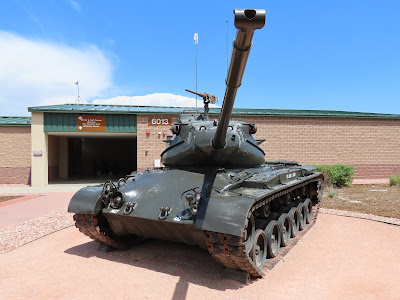Our Western trek next took us from Estes Park to Colorado Springs (144 miles). The Marriott Hotel where we stayed offers a great view of Pikes Peak.
That’s snow-capped Pikes Peak, elevation 14,115 feet, in this photo. Great views of the Rocky Mountains abound!
We would spend two nights in Colorado Springs where a highlight for me was going to Fort Carson, a nearby U.S. Army post where my family and I lived in the early 1970s.
When we lived here, as it is today, Fort Carson is home to the 4th Infantry Division, a fighting force with a rich history going back to World War I.
As the fort’s comptroller my father was responsible for all financial operations. He had this duty until after two years we was sent to Vietnam and the ongoing war there. While he was away, we moved off-post to a duplex in Colorado Springs.
The 4th ID has the nickname “Ivy Division” which is a play on the Roman numeral IV and its World War I patch of green ivy leaves attached. Ivy leaves symbolize tenacity and fidelity. The division’s motto is “Steadfast and Loyal.”
Not just anyone can get onto a military installation (including military dependents who used to live here). As civilians, we needed to first go into the Ft. Carson Visitor’s Center, located in front of the main gate. Here we needed to show our driver's licenses and vehicle registration. You must give a reason for your visit. In my case, I lived here for a few years as a kid and wanted to check out the old neighborhood.
I’m sure a background check is done, then we proceeded to a camera where our visitor pass was made. We showed them to the guards at the fort’s entrance gate. Then we were free to drive around the installation.
Since the Visitor’s Center is next to the Fort Carson Museum and an outside display of tanks we decided to check those out first.
I’ve always been interested in and impressed by the armor of World War II to the present day.
It was pretty cool to see these massive American weapons up close.
The M4 Sherman tank was America's work horse during World War II. More than 50,000 of these hulks were built from 1942-1945.
The museum was very interesting. It’s officially called the 4th ID and Fort Carson Museum- The Mountain Post Historical Center.
It is fairly small in size but has excellent displays.
It is laid out in chronological order.
The 4th Infantry Division pre-dates Camp Carson and that part is explained and depicted.
The division was formed at Camp Greene, N.C. In November 1917.
By Spring 1918 thousands of American soldiers were in France preparing to fight the Germans. And in that summer and fall, they did. The U.S. forces were instrumental in Germany’s surrender on Nov. 11, 1918.
Camp Carson-trained soldiers fought the Germans again in World War II.
Very realistic right?
Service in the Vietnam War is also represented.
As is 4th ID involvement in the Iraq Wars.
Intelligence and other units of the 4th ID successfully captured Iraqi dictator Saddam Hussein in December 2003. Read about "Operations Red Dawn" here.
I enjoyed the 30-40 minutes we spent in the military museum. I even made a new friend!
With our GPS, we quickly found St. Lo Drive (named for a World War II battle) where our family lived, gosh, more than 50 years ago. I clearly remember the big hill behind our neighborhood. We would play back there, ride bikes and kids with mini-bikes would race along the paths. We climbed the hill to the water tower a time or two.
There was, if I remember correctly, only one water tower back then. Today there are two.
Being back here became even more memorable when I photographed this Western Meadowlark, a lifer bird for me. See more on my Summer 2024 Western birding adventures in this post.
This is the street where we lived. It looks wider and newer than I remember. Credit to my brother Pete for remembering our address.
There is still 26 St. Lo Drive but the house here now with that number is not the house where we lived.
There’s a larger two-story home now at the address. Our house was similar to the red brick one-story ranch-style dwellings you see here.
It was neat to see the old stomping grounds. We even had a nice chat with the wife of a top officer who lives in this neighborhood. She has a South Carolina connection so that was cool.
The post’s highest-ranking officers live in the old hood. I guess they did too in the early 1970s when we lived here. My pops was certainly a high-ranking officer so it makes sense. He was either a major or lieutenant colonel at that point in his U.S. Army career.
It looks more “upscale” today than I remember. I’m sure the homes have been upgraded a time or two from 50-odd years ago.
The Post Exchange or PX at Ft. Carson is certainly nicer than I remember. We were able to go in and buy a few things. It too looks very upscale. Good for the soldiers serving our country to have such a nice place on post to shop, relax…and get their hair cut.
Ft. Carson has come far in many positive ways but its core mission remains: ready to defend America at a moment’s notice. “Steadfast and Loyal” forever! It was great to be back for a brief visit!







































No comments:
Post a Comment